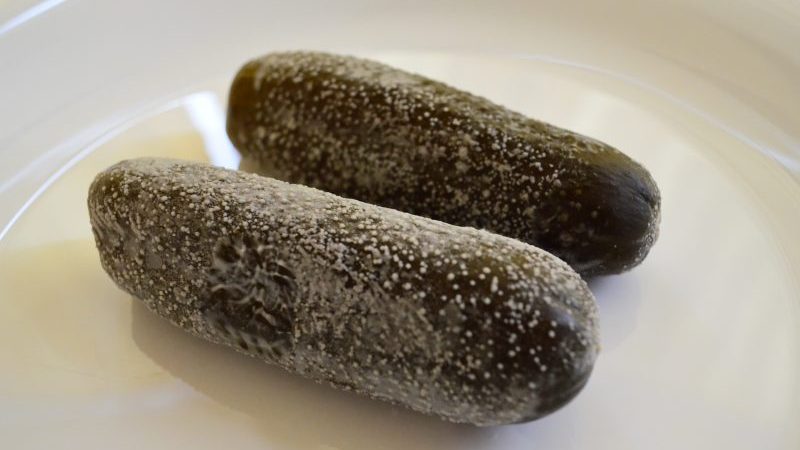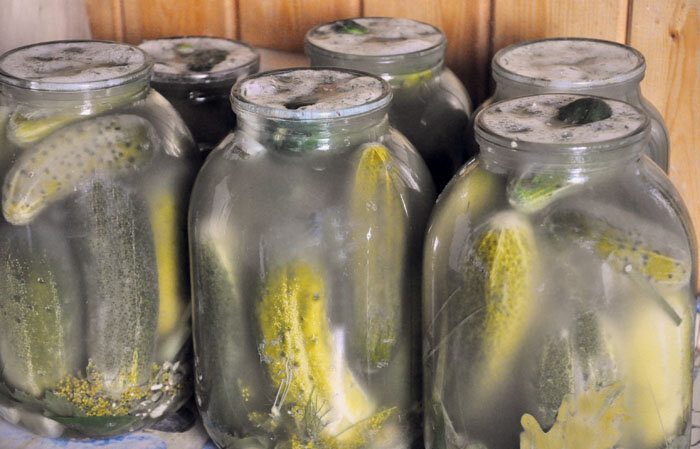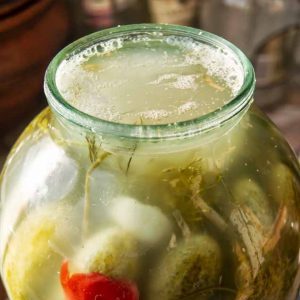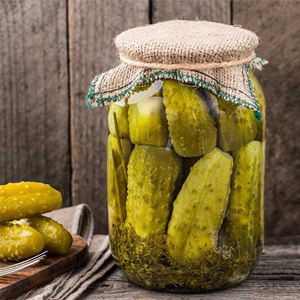Why does a white bloom appear on pickled cucumbers and is it possible to eat them
The appearance of a white coating on pickles does not always indicate that they are moldy. This color is provoked by the processes of fermentation and growth of lactic acid bacteria. The presence of putrefactive microorganisms is evidenced by the unpleasant smell and softness of vegetables.
The article will tell you why a white coating appears on pickles and whether they can be eaten.
The content of the article
White bloom on cucumbers - what is it
Such plaque has a different origin depending on the preparation technology and the composition of the workpiece.

How is formed
When cooked correctly, the plaque is safe for health and results from the activity of lactic acid bacteria... It is formed if vinegar was not added to the workpiece, the vegetables were completely covered with brine and did not come into contact with air.
White bloom caused by yeast or other harmful bacteria is dangerous. Such mold threatens with poisoning. If the fruits are infected with the bacillus Clostridium botulinum, their use will lead to a serious disease - botulism.
Moldy salty vegetables are determined not only by a white bloom, but also by other signs:
- unpleasant odor;
- the softness of the fruit.
Raid on pickled and lightly salted cucumbers occurs due to mold damage. Lactic acid is only produced in salted vegetables.
Moldy workpieces are disposed of. Trying to wash off the fungus is useless: vegetables are affected by it not only outside, but also inside.
Important! Before salting, vegetables are carefully sorted out and washed with running water. One spoiled fruit threatens to damage the entire contents of the jar.
The reasons

White bloom on pickles occurs for the following reasons:
- natural fermentation process;
- defeat by putrefactive bacteria, yeast due to improper preparation of the product or storage.
In the bank
Disruptions in cooking lead to moldy cucumbers in a jar:
- illiterate sterilization of glass containers and lids;
- lack of brine, in which it does not completely cover the cucumbers;
- poorly washed vegetables;
- Incorrect ingredients or wrong recipe
- getting into the can of air;
- use of varieties grown only for fresh consumption.
Another reason is non-compliance with the storage conditions for workpieces.
In a barrel
On barrel pickled cucumbers plaque is formed due to:
- non-compliance with the recipe;
- insufficient amount of brine;
- storage without oppression or in unsuitable conditions;
- sharp fluctuations in temperature.
Is it possible to eat such cucumbers
The safety of vegetables with a white coating depends on the nature of its origin.
Is raid dangerous

The formation of a layer of lactic acid, subject to the rules of salting, is a natural phenomenon caused by fermentation. A fermented product is good for health: natural probiotics inhibit the development of intestinal pathogenic microflora.
Such bacteria have a number of valuable properties:
- establish normal bowel function;
- stimulate the secretion of gastric juice;
- prevent constipation and diarrhea;
- help to strengthen the immune system;
- increase the resistance of the intestinal mucosa to various irritants;
- reduce the risk of developing an allergic reaction.
White bloom on vegetables due to improper preparation of the product or its storage is hazardous to health.
Important! A swollen can lid is another sign of a damaged workpiece.
When using cucumbers with a layer of mold, pathogenic microorganisms penetrate the body, which causes poisoning or botulism.
When can cucumbers be saved?
To get rid of the lactic acid layer, the vegetables are washed under running water, put into a clean glass container and filled with freshly prepared brine. This will extend the shelf life of the product.
Reference! If the cucumbers are stored in a barrel, just remove the top row.
In an already opened jar, the fruits are poured with fresh brine with the addition of mustard powder or grains mustard... This will not only protect against mold formation, but also make the cucumbers more crispy... Instead of mustard, horseradish root is suitable, which is put in a jar. From above, the contents of the container are covered with horseradish leaves.
When to discard the workpiece
Dispose of pickles affected by mold, with cloudy and unpleasantly smelling brine and soft fruits falling apart in the hands.
When buying a blank in a store, pay attention to the production date and shelf life. Expired product is not suitable for consumption.
How to salt properly
So that the cucumbers are not covered with a white coating, special attention is paid to sterilizing the jar with a lid and selecting the undamaged fruit.
Sterilization of cans and lids

To prevent canned food from deteriorating during storage and vegetables not covered with a white coating, it is important to properly sterilize containers.
They do it with:
- couple;
- boiling;
- electric furnaces;
- microwave ovens;
- potassium permanganate.
Pre-cans and lids are checked for integrity. The containers must be free of chips, and the lids must not be deformed.
Important! The container is thoroughly washed with baking soda or laundry soap.
For steam sterilization, take a pot of boiling water and a special grate for jars, which is installed over the pan. The container is placed in the device with the neck down and held until large drops of moisture appear. Lids are placed in boiling water for seaming. Put vegetables in the jar only after it is completely dry.
When boiling, the container is placed in a large container so that cold water completely covers it. The liquid is heated gradually so that the cans do not burst from a sharp temperature drop. The vessels are sterilized 5 minutes after boiling water.
Several cans are placed in the oven (electric oven) at the same time. They are placed with their throats down for 12 minutes at a temperature of + 120 ° C.
In a microwave oven, sterilize 1 three-liter jar or several half-liter. A small amount of water (1.5–2 cm) is poured into each. The power is set at 800 kW. Sterilization takes 3 minutes.
In a simpler version, a clean glass container is rinsed with a pink solution of potassium permanganate for disinfection from the inside.
Storage
Optimal conditions for workpieces: temperature - no higher than + 4 ° С, air humidity - 80–90%. The cellar fits well.
Reference! Salting in tightly closed jars is also stored in the apartment.
The vegetables removed from the brine jar are kept in the freezer. Excess moisture is preliminarily removed, fruits are packaged in small portions in plastic bags. Such cucumbers are cooked before use. They are used for pickle, pizza.
To increase the shelf life, barrel fruits are stored in the basement. The ideal temperature regime for them is 0 ... -1 ° С.
Storage nuances:
- brine pour in enough so that it completely covers the fruits;
- cucumbers are kept under oppression;
- do not allow temperature drops in the room.
Useful Tips
To prevent mold from vegetables, some subtleties are observed:
- mustard powder is not only poured into the jar, but mustard plaster is also dipped into it;
- black peppercorns are added to the brine.
At temperatures above + 1 ° C, the development of bacteria accelerates, and the fruits themselves deteriorate faster.
To extend the shelf life of barrel cucumbers in an apartment, they are washed, dried, put into a food container, sprinkling each layer with mustard powder.
Conclusion
White bloom on pickles is not always a sign of spoilage. The unsuitability of a product for consumption is determined by the presence of an unpleasant odor, cloudy brine and the softness of the fruit. Washing off mold from vegetables is not an option, as microorganisms get inside the fruit.
If the cooking technology is followed, lactic acid bacteria develop in the product, which are not only safe, but even beneficial to health.